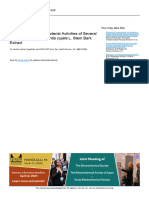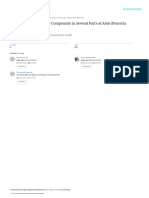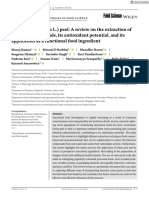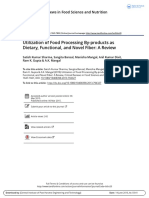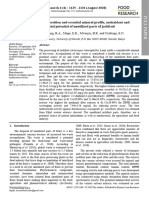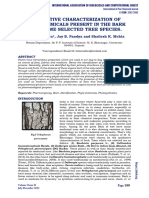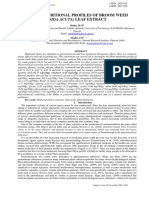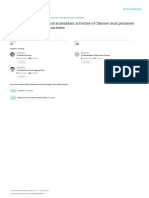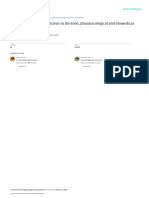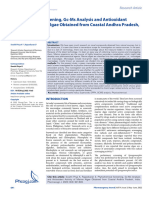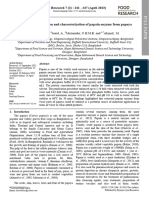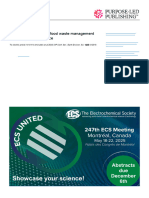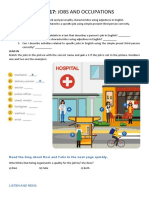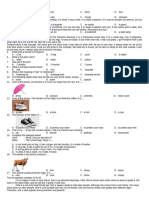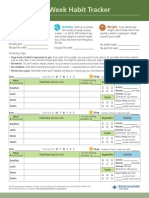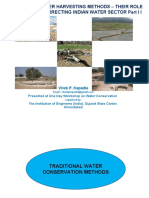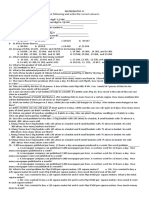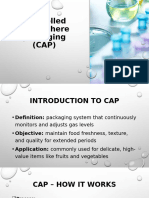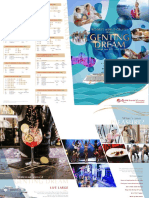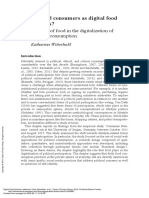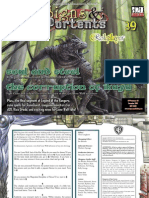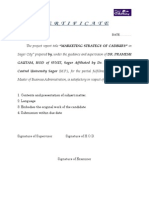Physicochemical character and antioxidant activity of lemon (Citrus Limon (L.) BURM. F.) beverage with addition of spice extract and honey as a functional drink _ AIP Conference Proceedings _ AIP Publishing
Physicochemical character and antioxidant activity of lemon (Citrus Limon (L.) BURM. F.) beverage with addition of spice extract and honey as a functional drink _ AIP Conference Proceedings _ AIP Publishing
Uploaded by
lukmanjunaidiCopyright:
Available Formats
Physicochemical character and antioxidant activity of lemon (Citrus Limon (L.) BURM. F.) beverage with addition of spice extract and honey as a functional drink _ AIP Conference Proceedings _ AIP Publishing
Physicochemical character and antioxidant activity of lemon (Citrus Limon (L.) BURM. F.) beverage with addition of spice extract and honey as a functional drink _ AIP Conference Proceedings _ AIP Publishing
Uploaded by
lukmanjunaidiCopyright
Available Formats
Share this document
Did you find this document useful?
Is this content inappropriate?
Copyright:
Available Formats
Physicochemical character and antioxidant activity of lemon (Citrus Limon (L.) BURM. F.) beverage with addition of spice extract and honey as a functional drink _ AIP Conference Proceedings _ AIP Publishing
Physicochemical character and antioxidant activity of lemon (Citrus Limon (L.) BURM. F.) beverage with addition of spice extract and honey as a functional drink _ AIP Conference Proceedings _ AIP Publishing
Uploaded by
lukmanjunaidiCopyright:
Available Formats
Search...
AIP Conference Proceedings Advanced Search | Citation Search
Lukman Junaidi
HOME BROWSE FOR AUTHORS FOR ORGANIZERS ABOUT
Volume 2957, Issue 1 RESEARCH ARTICLE | FEBRUARY 06 2024
6 February 2024 Physicochemical character and antioxidant activity View Metrics
of lemon (Citrus Limon (L.) BURM. F.) beverage with
addition of spice extract and honey as a functional
drink Citing Articles Via
Nami Lestari ; Lukman Junaidi; Eddy Sapto Hartanto; Reno Fitri Hasrini; Tita Aviana;
Rhoito Frista Silitonga; Ainun Khoiriyah Google Scholar
Author & Article Information
AIP Conf. Proc. 2957, 060015 (2024) Publish with us -
https://doi.org/10.1063/5.0185400
Request a Quote!
PROCEEDINGS OF THE Share Tools
1ST INTERNATIONAL
CONFERENCE ON FOOD
AND AGRICULTURAL Lemon (Citrus limon (L) Burm. f.) has important economic value due to it contains
SCIENCES (ICFAS) 2022: vitamin C (ascorbic acid), flavonoid glycosides, coumarins, and essential oils. Vitamin
Advanced Agricultural
Technology to Deal with C is known as a very powerful antioxidant. In addition to lemon, spices such as ginger,
Climate Change Issues for
Achieving Food Security lemongrass, star anise, cinnamon, nutmeg, and cloves also contain antioxidants. The
purpose of this study was to determine the physicochemical character and antioxidant
activity of packaged honey-spiced lemon functional beverage products. The research
was conducted by preparing functional drinks made from lemon juice plus honey and
extracts of several types of spices such as ginger, lemongrass, star anise, cinnamon,
nutmeg flesh, and cloves. The product is packaged in a plastic bottle. The results
showed that the physicochemical properties of the product consisted of moisture
content 92.0–92.6%, ash content 0.12–0.19%, total dissolved solid 8.44–8.75%, pH
2.69–2.78, the amount of sugar (saccharose) 6.17–7.29%, total acid 0.50–0.57%,
Sign up for alerts
vitamin C 0.5 mg/kg and total phenol 63.6–94.3 mg/kg. Antioxidant activity (DPPH
method) ranged from 32.79 ppm to 263.63 ppm. The highest value of antioxidant
activity was obtained in functional drinks made from lemon, honey, and star anise,
which was 263.63 ppm. Most Read Most Cited
Topics
Android phone hacking and impact via
Coumarin, Chemical properties, Free radicals, Ascorbate, Flavonoid, Vitamins androrat
REFERENCES Phytochemical analysis of bioactive
compounds in ethanolic extract of
1. P. Garcia-Salas, A. M. Gomez-Caravaca, D. Arráez-Roman, A. Segura-
Sterculia quadrifida R.Br.
Carretero, E. Guerra-Hernández, B. García-Villanova and A. Fernández-Gutiérrez,
Food Chem. 141(2), 869–878 (2013).
https://doi.org/10.1016/j.foodchem.2013.02.124
Preface: First International Conference on
Crossref PubMed
Food and Agricultural Sciences (ICFAS
2. C. C. Ngugi, E. Oyoo-Okoth and M. Muchiri, Aquac. Res. 48(5), 2253–2265 2022)
(2017). https://doi.org/10.1111/are.13062
Crossref
3. J. A. Del Rıo, M. D. Fuster, P. Gomez, I. Porras, A. Garcıa-Lidon and A. Ortuno,
Food Chem. 84(3), 457–461. (2004).
https://doi.org/10.1016/S0308-8146(03)00272-3
Crossref
4. E. González-Molina, D. A. Moreno, and C. García-Viguera, Journal of
Agricultural and Food Chemistry 56(5), 1669–1675 (2008).
https://doi.org/10.1021/jf073282w
Crossref PubMed
5. A. Gil-Izquierdo, M. T. Riquelme, I. Porras and F. Ferreres, J. Agric. Food
Chem. 52(2), 324–331 (2004). https://doi.org/10.1021/jf0304775
Crossref PubMed
6. J. J. Peterson, G. R. Beecher, S. A. Bhagwat, J. T. Dwyer, S. E. Gebhardt, and
D. B. Haytowitz, Journal of Food Composition and Analysis 19, S74–S80 (Suppl. )
(2006). https://doi.org/10.1016/j.jfca.2005.12.009
Crossref
7. M. G. L. Hertog, P. C. H. Hollman and B. Van de Putte, Journal of Agricultural
and Food Chemistry 41(8), 1242–1246 (1993). https://doi.org/10.1021/jf00032a015
Crossref
8. A. Skoczynıska, I. Jedrychowska, R. Poreba, A. Affelska-Jercha, B. Turczyn, A.
Wojakowska and R. Andrzejak, Pharmacol. Rep. 59, 177–182 (2007).
9. L. Sueiro, G. G. Yousef, D. Seigler, E. G. De Mejia, M. H. Grace and M. A. Lila,
J. Food Sci. 71, C480–C488 (2006).
https://doi.org/10.1111/j.1750-3841.2006.00152.x
Crossref
10. M. V. Albertini, E. Carcout, O. Pailly, C. Gambotti, F. Luro and L. Berti, J.
Agric. Food Chem. 54(21), 8335–8339 (2006). https://doi.org/10.1021/jf061648j
Crossref PubMed
11. F. Giampieri, J. M. Alvarez-Suarez, L. Mazzoni, T. Y. Forbes-Hernandez, M.
Gasparrini and A. M. Gonzalez-Paramas, Molecules 19(6), 7798–7816 (2014).
https://doi.org/10.3390/molecules19067798
Crossref PubMed
12. A. Brito, J. E. Ramirez, C. Areche, B. Sepulveda and M. J. Simirgiotis,
Molecules 19(11), 17400–17421 (2014).
https://doi.org/10.3390/molecules191117400
Crossref PubMed
13. A. Girones-Vilaplana, P. Valentão, P. B. Andrade, F. Ferreres, D. A. Moreno
and C. García-Viguera, Food Chemistry 134(4), 2090–2096 (2012).
https://doi.org/10.1016/j.foodchem.2012.04.010
Crossref PubMed
14. P. T. Gardner, T. A. C. White, D. B. McPhail, and G. G. Duthie, Food Chem.
68, 471–474 (2000). https://doi.org/10.1016/S0308-8146(99)00225-3
Crossref
15. P. Rapisarda, A. Tomaino, R. L. Cascio, F. Bonina, A. De-Pasquale and A.
Saija, J. Agric. Food Chem. 47, 4718–4723 (1999).
https://doi.org/10.1021/jf990111l
Crossref PubMed
16. K. M. Yoo, K. W. Lee, J. B. Park, H. J. Lee, and I. K. Hwang, J. Agric. Food
Chem. 52, 5907–5913 (2004). https://doi.org/10.1021/jf0498158
Crossref PubMed
17. A. Kurniawan, C. Kurniawan, N. Indraswati and Mudjijati, Widya Teknik 7(1),
15–24 (2008).
18. Monika, “Formulasi dan penentuan umur simpan minuman fungsional
campuran sirih merah, jahe, kayu manis dan jeruk nipis”, S1 thesis, Fateta-IPB
Bogor, 2013.
19. A. B. Tawali, Journal Sosial Ekonomi Unhas No 17 (2004).
20. Indrayana, “Efek antioksidan ekstrak etanol 70% daun salam (Syaigium
polyanthum [Wight] Walp. ) pada serum darah tikus putih jantan”, S1 thesis,
Fakultas Farmasi Univ. Muhammadiyah, 2008.
Google Scholar
21. H. Winarsi, Antioksidan Alami dan Radikal Bebas (Kanisius, Yogyakarta,
2007)
Google Scholar
22. S. Burda and W. Oleszek, J. Agr. Food Chem. 49, 2774–2997 (2001).
https://doi.org/10.1021/jf001413m
Crossref
23. G. C. Yen and P. D. Duh, J. Agric. Oil Chem. Soc. 70, 383–386 (1993).
https://doi.org/10.1007/BF02552711
Crossref
24. M. L. Fardeau, Y. Benmalek, O. A. Yahia and A. Belkebir, Bioengineered
Journal 4(4), 244–248 (2013). https://doi.org/10.4161/bioe.24435
Crossref
25. Rauf, Rusdin, E. Purwani and E. N. Widiyaningsih, Jurnal Teknologi Hasil
Pertanian, IV(2), 120–125 (2011).
26. R. Rahman, M. Akram, N. Akhtar, Q. Jabeen, T. Saeed, S. M. A. Shah, K.
Ahmed, G. Shaheen, and H. M. Asif, Journal of Medicinal Plants Research 5, 344–
348 (2011).
27. E. Rita and D. R. Ningtyas, “Pemanfaatan Cymbopogon nardus sebagai
larvasida Aedes aegypti”, S1 thesis, Jurusan Pendidikan Biologi IKIP PGRI
Semarang, 2009.
28. D. Basuki, “Aktifitas anti bakteri ekstrak etil asetat tanaman serai
(Cymbopogon nardus (L. ) Rendle) terhadap Escherichia coli dan Staphylococcus
aureus multiresisten serta bioautografinya”, S1 thesis, Jurusan Farmasi Fakultas
Farmasi Universitas Muhammadiyah Surakarta, 2011.
Google Scholar
29. F. Indriaty, Y. Assah and S. N. Mamahani, 2015. “Serbuk Minuman Berbasis
Daging Buah Pala” (Baristand Manado, Manado, 2015).
Google Scholar
30. A. D. Gupta, V. K. Bansal, V. Babu, and N. Maithil, J. Genet. Eng. Biotechol.
11, 25–31 (2013). https://doi.org/10.1016/j.jgeb.2012.12.001
Crossref
31. M. Latief, F. Tafzi, and A. Saputra, “Aktivitas Antioksidan Minyak Kayu Manis
(Cinnamomum burmanii) Asal Kabupaten Kerinci Profinsi Jambi (Universitas
Lampung, Lampung, 2013).
Google Scholar
32. Suryanto, “Fitokimia Antioksidan” (CV Putra Media Nusantara (PMN),
Surabaya, 2012).
Google Scholar
33. F. Liu, W. J. Fu, D. R. Yang, Y. Q. Peng, X. W. Zhang and J. Z. He, Food.
Journal of Apicultural Research, 43, 153–157 (2004).
34. M. H. Gordon, “The Mechanism of Antioxidant Action in Vitro in Food
Antioxidants, edited by B. J. F. Hudson (Elsevier Applied Science, London, 1990),
pp 1–18.
Google Scholar
35. P. D. Duh, J. Agric. Oil. Chem. Soc. 75(4), 455–461 (1998).
https://doi.org/10.1007/s11746-998-0248-8
Crossref
36. L. S. Lai, S. T. Chou and W. W. Chao, J. Agric. Food Chem. 49, 963–968
(2001). https://doi.org/10.1021/jf001146k
Crossref PubMed
This content is only available via PDF.
©2024 Authors. Published by AIP Publishing.
You do not currently have access to this content.
Pay-Per-View Access $40.00
BUY THIS ARTICLE
Online ISSN 1551-7616 Print ISSN 0094-243X
Resources Explore pubs.aip.org Connect with AIP Publishing
For Researchers Journals About Facebook
For Librarians Physics Today User Guide LinkedIn
For Advertisers Conference Proceedings Contact Us Twitter
Our Publishing Partners Books Register YouTube
Special Topics Help
Publishers Privacy Policy
Terms of Use
© Copyright 2024 AIP Publishing LLC
You might also like
- Beyond The Rim 1 - Free Jump ProgramDocument216 pagesBeyond The Rim 1 - Free Jump ProgramElias VaziryNo ratings yet
- Fish & Shellfish Cooking MethodsDocument14 pagesFish & Shellfish Cooking Methodsprincess julie ann bayogosNo ratings yet
- Fast Food Restaurant Daily Sales RecordDocument7 pagesFast Food Restaurant Daily Sales RecordWaqas Siddique SammaNo ratings yet
- Kelapa Kopyor InternDocument7 pagesKelapa Kopyor InternPutri Amalia IsnainiNo ratings yet
- Syaefudin 2018 IOP Conf. Ser. Earth Environ. Sci. 197 012004Document10 pagesSyaefudin 2018 IOP Conf. Ser. Earth Environ. Sci. 197 012004De'Uma Beiby SwettyNo ratings yet
- Fsufs 08 1354393Document9 pagesFsufs 08 1354393dangvy220976No ratings yet
- Microbial Ecology and Habitat Book Microbial Contamination of Food and MilkDocument50 pagesMicrobial Ecology and Habitat Book Microbial Contamination of Food and Milkayman hanif100% (1)
- Chemical Compositions of Pycnarrhena LongifoliaDocument9 pagesChemical Compositions of Pycnarrhena LongifoliaGendost Horop GedrikNo ratings yet
- Identification of Volatile Compounds in Several Parts of Abiu (Pouteria Caimito)Document8 pagesIdentification of Volatile Compounds in Several Parts of Abiu (Pouteria Caimito)Alice MouraNo ratings yet
- 5 Fr-Ihcret-002 SukirahDocument10 pages5 Fr-Ihcret-002 Sukirahshashanicol8No ratings yet
- Journal of Food Science - 2022 - Kumar - Onion Allium Cepa L Peel A Review On The Extraction of Bioactive CompoundsDocument23 pagesJournal of Food Science - 2022 - Kumar - Onion Allium Cepa L Peel A Review On The Extraction of Bioactive CompoundsPranitNo ratings yet
- Ebook PDFDocument224 pagesEbook PDFJorion RomenggaNo ratings yet
- Manish STUDYONAQUEOUSEXTRACTOFCitrusDocument5 pagesManish STUDYONAQUEOUSEXTRACTOFCitrusZurielle LuboaNo ratings yet
- Ecj 175 181Document8 pagesEcj 175 181aristyawanandhikadwiNo ratings yet
- Effect of Different Drying Methods On NutritionalDocument10 pagesEffect of Different Drying Methods On Nutritionalahmedshahriar486No ratings yet
- Aloe Vera Gel - MushroomDocument46 pagesAloe Vera Gel - MushroomPhan Nguyễn TrangNo ratings yet
- Preparation of Medicinal Soap Products Using The Leaf Extracts of Punica Granatum (Pomegranate)Document11 pagesPreparation of Medicinal Soap Products Using The Leaf Extracts of Punica Granatum (Pomegranate)jayasenashanikaNo ratings yet
- Utilization of Food Processing By-Products As Dietary, Functional, and Novel Fiber: A ReviewDocument16 pagesUtilization of Food Processing By-Products As Dietary, Functional, and Novel Fiber: A ReviewKhaled Abu-AlruzNo ratings yet
- Chemoprofiling and Medicinal Potential of Underutilized Leaves of Cyperus ScariosusDocument19 pagesChemoprofiling and Medicinal Potential of Underutilized Leaves of Cyperus ScariosusAlex JosephNo ratings yet
- Food Science Nutrition - 2019 - Farahmandfar - Bioactive Compounds Antioxidant and Antimicrobial Activities of ArumDocument11 pagesFood Science Nutrition - 2019 - Farahmandfar - Bioactive Compounds Antioxidant and Antimicrobial Activities of ArumSafira R. AissyNo ratings yet
- Evaluation of The Cytotoxicity Potential of Ethanolic Extract of Chrysophyllum Cainito Using The Brine Shrimp Lethality BioassayDocument7 pagesEvaluation of The Cytotoxicity Potential of Ethanolic Extract of Chrysophyllum Cainito Using The Brine Shrimp Lethality BioassayLeonel LumogdangNo ratings yet
- Food Science Nutrition - 2014 - Seo - Study To Find The Best Extraction Solvent For Use With Guava Leaves PsidiumDocument7 pagesFood Science Nutrition - 2014 - Seo - Study To Find The Best Extraction Solvent For Use With Guava Leaves PsidiumYAN DHENA YANTINo ratings yet
- Ethanol ExtrDocument11 pagesEthanol Extralishbah qayyumNo ratings yet
- 1 s2.0 S2665927121000332 MainDocument10 pages1 s2.0 S2665927121000332 MainLaires AraujoNo ratings yet
- 837 Ijar-2434Document6 pages837 Ijar-2434tayyaba mehmoodNo ratings yet
- 1 s2.0 S2666154324000516 Main1Document12 pages1 s2.0 S2666154324000516 Main1nihal70571999No ratings yet
- Plums A Brief IntroductionDocument6 pagesPlums A Brief IntroductionfatikanafiolaNo ratings yet
- Thumb Impression TestDocument11 pagesThumb Impression TestArshia NazirNo ratings yet
- Jurnal Inggris Kulit JerukDocument18 pagesJurnal Inggris Kulit JerukSesi kumala dewiNo ratings yet
- Efficacy of Plant Based Natural Preservatives in Extending Shel - 2022 - AppliedDocument10 pagesEfficacy of Plant Based Natural Preservatives in Extending Shel - 2022 - AppliedLê Quốc Đăng KhoaNo ratings yet
- 24 fr-2019-326 Adan 1Document10 pages24 fr-2019-326 Adan 1thtien250303No ratings yet
- Qualitative Characterization of Phytochemicals Present in The Bark From Some Selected Tree SpeciesDocument8 pagesQualitative Characterization of Phytochemicals Present in The Bark From Some Selected Tree Specieslem gajahNo ratings yet
- Antioxidant Activity and Phytochemical Analysis ofDocument9 pagesAntioxidant Activity and Phytochemical Analysis oftafiyau7912No ratings yet
- Effect of Microwave Blanching OnDocument7 pagesEffect of Microwave Blanching OnYves MartialNo ratings yet
- PharmMethods 10 2 70Document10 pagesPharmMethods 10 2 70airaaa0403No ratings yet
- Phyto-Nutritional Profiles of Broom Weed (Sida Acuta) Leaf ExtractDocument6 pagesPhyto-Nutritional Profiles of Broom Weed (Sida Acuta) Leaf ExtractresearchparksNo ratings yet
- Food Research International: Naciye Erkan, Huseyin Cetin, Erol AyranciDocument7 pagesFood Research International: Naciye Erkan, Huseyin Cetin, Erol Ayranciкатя калайдаNo ratings yet
- Chen, 2023. Microalgal Polyunsaturated Fatty Acids Hotspots and Production TechniquesDocument22 pagesChen, 2023. Microalgal Polyunsaturated Fatty Acids Hotspots and Production TechniquesM Rizki Ariansyah putraNo ratings yet
- Comparative Evaluation of Soxhlet and UltrasonicsDocument9 pagesComparative Evaluation of Soxhlet and UltrasonicsBagasNo ratings yet
- Flavonoid Composition and Antioxidant Activities of Chinese Local Pummelo (Citrus Grandis Osbeck.) VarietiesDocument10 pagesFlavonoid Composition and Antioxidant Activities of Chinese Local Pummelo (Citrus Grandis Osbeck.) Varietiesณัฐ มีบุญNo ratings yet
- AshgourdanditsapplicationsPaperDocument12 pagesAshgourdanditsapplicationsPaperpavanNo ratings yet
- OleoresinDocument9 pagesOleoresinhabibatus latifah2No ratings yet
- FR 2019 333Document7 pagesFR 2019 333salimabdatNo ratings yet
- Oleoresin2017 PDFDocument9 pagesOleoresin2017 PDFHabibatus LatifahNo ratings yet
- Ultrasound-Assisted Extraction of Natural Antioxidants From The Ower of Limonium Sinuatum: Optimization and Comparison With Conventional MethodsDocument8 pagesUltrasound-Assisted Extraction of Natural Antioxidants From The Ower of Limonium Sinuatum: Optimization and Comparison With Conventional MethodsJohn JohnNo ratings yet
- Bioactive Compounds and Antioxidant Potential of Mango Peel ExtractDocument7 pagesBioactive Compounds and Antioxidant Potential of Mango Peel ExtractsushilkumarjwankhadeNo ratings yet
- PC Mibu Effect Green GramDocument11 pagesPC Mibu Effect Green GramKristen DumagoNo ratings yet
- Proximatecompositionof IpomeaaquaticforskDocument8 pagesProximatecompositionof IpomeaaquaticforskElleisseNo ratings yet
- My Research Publication 2Document9 pagesMy Research Publication 2Samuel UzonduNo ratings yet
- Molecules 27 07102 v2Document17 pagesMolecules 27 07102 v2JOSUE YALENo ratings yet
- 8bklt-Gc Ms AlgaeDocument9 pages8bklt-Gc Ms AlgaenaylaaqilahzaharaNo ratings yet
- JFCA ResearchDocument13 pagesJFCA Researchkirty.pantNo ratings yet
- Comparative Studies On Antioxidant and Anti-InflamDocument8 pagesComparative Studies On Antioxidant and Anti-Inflaml100% (1)
- 30 fr-2021-723 KhatunDocument7 pages30 fr-2021-723 KhatunHARSHAL NANDURKARNo ratings yet
- Influence of Sustainable Biocoagulants Trigonella Foenum Graecum and Moringa Oleifera For Improving Water PotabilityDocument8 pagesInfluence of Sustainable Biocoagulants Trigonella Foenum Graecum and Moringa Oleifera For Improving Water PotabilityEditor IJTSRDNo ratings yet
- Jaggery1 PDFDocument8 pagesJaggery1 PDFValerie UrsalNo ratings yet
- QQQ QQQQQQDocument4 pagesQQQ QQQQQQDisco YKNo ratings yet
- Food Chemistry: Yongqiang Wang, Yujie Gao, Hui Ding, Shejiang Liu, Xu Han, Jianzhou Gui, Dan LiuDocument7 pagesFood Chemistry: Yongqiang Wang, Yujie Gao, Hui Ding, Shejiang Liu, Xu Han, Jianzhou Gui, Dan LiuDessy Erlyani Mugita SariNo ratings yet
- Food Research International 119 (2019) 455-461Document7 pagesFood Research International 119 (2019) 455-461Iris Bustamante PájaroNo ratings yet
- Chemical Composition, Antioxidant, and Antimicrobial Activities of P. Roxburghii Oleoresin Essential Oils Extracted by Steam Distillation, Superheated Steam, and Supercritical Fluid CO2 ExtractionDocument14 pagesChemical Composition, Antioxidant, and Antimicrobial Activities of P. Roxburghii Oleoresin Essential Oils Extracted by Steam Distillation, Superheated Steam, and Supercritical Fluid CO2 Extractionmuhammad adnan ayubNo ratings yet
- Amiruddin 2023 IOP Conf. Ser. Earth Environ. Sci. 1205 012018Document7 pagesAmiruddin 2023 IOP Conf. Ser. Earth Environ. Sci. 1205 012018Jeny PerpetuaNo ratings yet
- Postharvest Biology and Technology of Fruits, Vegetables, and FlowersFrom EverandPostharvest Biology and Technology of Fruits, Vegetables, and FlowersNo ratings yet
- Bioactives in Fruit: Health Benefits and Functional FoodsFrom EverandBioactives in Fruit: Health Benefits and Functional FoodsMargot SkinnerNo ratings yet
- SITXHRM006 Assessment 2 - Project DoneDocument20 pagesSITXHRM006 Assessment 2 - Project DoneSami Khan100% (1)
- Hafsa and The Magical RingDocument31 pagesHafsa and The Magical RingKuwaiccorjja BaiNo ratings yet
- Week 17 - Aprendo en Casa 05 - 09 Octubre - Inglés 5toDocument6 pagesWeek 17 - Aprendo en Casa 05 - 09 Octubre - Inglés 5toBeth Varillas AlaniaNo ratings yet
- Soal Pat Bahasa Inggris Kelas 7 Semester 1Document3 pagesSoal Pat Bahasa Inggris Kelas 7 Semester 1Mts MaarifNo ratings yet
- 1-Week Habit TrackerDocument2 pages1-Week Habit TrackerHai NguyenNo ratings yet
- Canada Alberta JOBS For Lethbridge/Waterton and SW Alberta: 650 Total No. of JobsDocument16 pagesCanada Alberta JOBS For Lethbridge/Waterton and SW Alberta: 650 Total No. of Jobsapi-184943554No ratings yet
- தரம் 09 PDFDocument41 pagesதரம் 09 PDFஅகரம் தினேஸ்No ratings yet
- Traditional Water Harvesting Methods - Their Role and Scope in Correcting Indian Water Sector Part I IDocument47 pagesTraditional Water Harvesting Methods - Their Role and Scope in Correcting Indian Water Sector Part I IDavid MediNo ratings yet
- Super Voodoo CourseDocument935 pagesSuper Voodoo CourseCaio Viana0% (1)
- Pengelolaan Hotel (Kitchen) - NadaDocument6 pagesPengelolaan Hotel (Kitchen) - NadaAlya nada zainNo ratings yet
- MATHEMATICS IV ReviewerDocument2 pagesMATHEMATICS IV Reviewerrea sapinNo ratings yet
- Controlled Atmosphere Packaging (CAP)Document13 pagesControlled Atmosphere Packaging (CAP)bhaswatidas1998No ratings yet
- Listening 2Document2 pagesListening 2AilsaNo ratings yet
- 2.4 Pickling: Chapter 2: Fruits and Vegetables Chapter 2: Fruits and VegetablesDocument24 pages2.4 Pickling: Chapter 2: Fruits and Vegetables Chapter 2: Fruits and VegetablesSyahirah FazialNo ratings yet
- Cpi IndexDocument38 pagesCpi IndexChandreshDharDubeyNo ratings yet
- Muntingia CalaburaDocument12 pagesMuntingia CalaburaLailaNo ratings yet
- Winds Fall-Winter 2019 - 2020 Dinner MenuDocument2 pagesWinds Fall-Winter 2019 - 2020 Dinner MenuwoodNo ratings yet
- Genting Dream Luxury Cruise From Singapore Starting 15jun22Document6 pagesGenting Dream Luxury Cruise From Singapore Starting 15jun22Ishaan AsthanaNo ratings yet
- Ref CkeDocument3 pagesRef CkeZoem de LeozNo ratings yet
- Digital Food Activism PDFDocument21 pagesDigital Food Activism PDFYasmina BakryNo ratings yet
- Babylon 5 RPG Techno Mage 1st PartDocument68 pagesBabylon 5 RPG Techno Mage 1st Partseppun1100% (4)
- Embassy Kitchens PDFDocument49 pagesEmbassy Kitchens PDFWar LinuxNo ratings yet
- Cadbury Brand ValueDocument50 pagesCadbury Brand Valuej_sachin09No ratings yet
- Chocolate Confectionery in Western EuropeDocument57 pagesChocolate Confectionery in Western EuropeEmmanuel DiazNo ratings yet
- Malnutrition DisordersDocument47 pagesMalnutrition DisordersAnnisa AstariNo ratings yet
- Final Exam Basic 1Document6 pagesFinal Exam Basic 1Heidy ValdezNo ratings yet
- List of FPOs in The State of RajasthanDocument6 pagesList of FPOs in The State of RajasthanAnwesha MondalNo ratings yet




